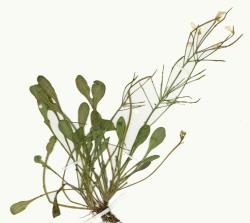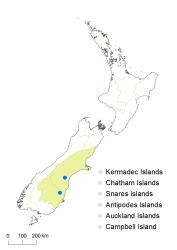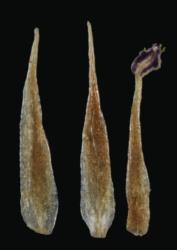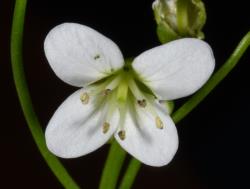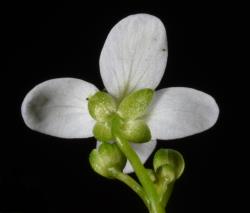Perennial herb, single rosette or with short lateral branches. Leaves up to 115 mm long, usually simple or irregularly pinnatifid; lamina 14.0–33.0 × 4.0–11.5 mm, grey to grey-green, coriaceous, glabrous; petiole up to 90 mm long. Terminal pinna 14.0–20.0 × 4.0–11.5 mm, simple, elliptic, broadly elliptic to obovate; margin entire, without hydathodes; apex obtuse with a ± distinct hydathode; base cuneate to attenuate. Lateral lobes 1–2, basal, 0.5–3.0 × 1.5–3.5 mm, broadly triangular to broadly elliptic; apex obtuse. Cauline leaves similar to rosette leaves but smaller, narrower, base attenuate. Inflorescence racemose, often with lateral racemes, each raceme 6–20-flowered; peduncle up to 140 mm long, 1.2–1.3 mm diam. at base, ascending, glabrous. Pedicels 15.0–26.0 mm long, 0.4–0.6 mm diam., ascending or divaricate, glabrous. Sepals 2.5–3.0 × 1.4–1.8 mm, broadly elliptic, saccate, green, glabrous, margin white and membranous, apex obtuse, base truncate. Petals 9.5–11.0 × 3.8–5.0 mm, white, limb obovate; apex obtuse; base attenuate, tapering to a c. 0.2 mm long claw. Stamens 6, dilated in lower half, 0.35–0.65 mm wide; median filaments 4, 3.6–4.4 mm long; lateral filaments 2, 2.3–2.9 mm long; anthers 0.7–0.8 mm long, maroon, when dehiscent held slightly below the stigma. Ovary 2.5–4.0 mm long, 0.5–0.6 mm diam., ± terete, green, glabrous; ovules 36–40; style 0.9–1.0 mm long, ± terete; stigma 0.3–0.4 mm diam. Siliques 21.0–29.0 × 0.9–1.1 mm, glabrous, style 1.0–1.2 mm long; valves green when developing. Seeds not seen.
Cardamine dilatata is distinguished from C. bilobata by its mostly simple to irregularly lobed grey to grey-green leaves, filaments conspicuously dilated at the base, and the silique with a short style.
Cardamine dilatata is known from two collections at the type locality in the Pareora River gorge, South Canterbury, and a subpopulation of 11 plants at Macraes, North Otago. At Pareora it was growing on a narrow, moss-covered ledge on a shaded, south-facing mudstone bluff beside the Pareora River, and at Macraes it was growing on the lower parts of large, south-facing schist bluffs that do not receive direct sunshine.
Cardamine dilatata is assessed as having a conservation status of Threatened, Nationally Critical (A1), with the qualifier Data Poor (de Lange et al. 2018). The qualifier Data Poor is applied as additional information on the number and size of the populations is required.
Flowering December; Fruiting December.



